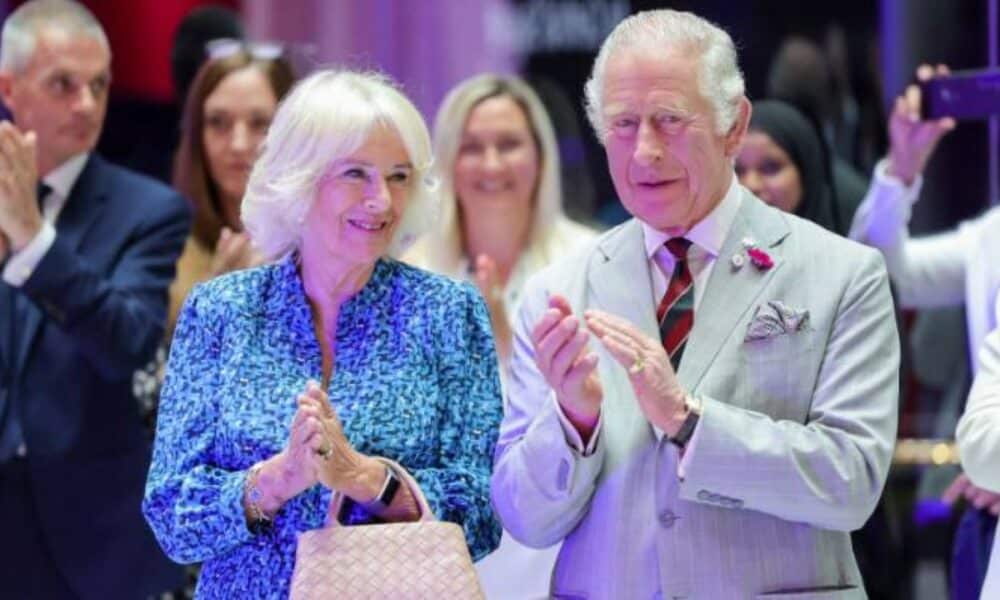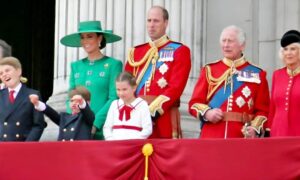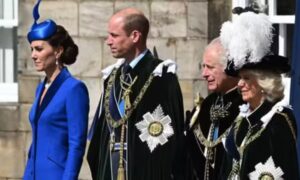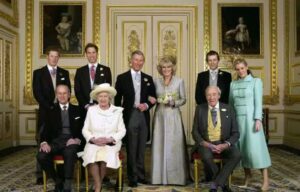from public scrutiny to royal acceptance and influence
Born on July 17, 1947, in London, Queen Camilla’s life has been one of transformation, resilience, and steady commitment to public service. Her journey from being a controversial figure in British society to becoming an integral part of the monarchy is a testament to perseverance and adaptability. Raised in East Sussex, she came from an aristocratic background, being the daughter of Major Bruce Shand and Rosalind Shand, with close ties to the British establishment. Her formative years were spent between England, Switzerland, and France, where she received a refined education that would later serve her well in royal duties. Over the years, Camilla’s public image shifted significantly, moving from widespread criticism to a level of acceptance and admiration among royal watchers and the public alike.
Her first marriage to Andrew Parker Bowles in 1973 was viewed as the traditional path for women of her social standing. The couple had two children, Tom Parker Bowles and Laura Lopes, both of whom have maintained a degree of privacy despite their proximity to the royal family. However, her deep-rooted connection with Charles, now King Charles III, was a subject of intense media scrutiny. The collapse of Charles’ marriage to Princess Diana in the 1990s intensified negative perceptions of Camilla, making her one of the most scrutinized figures in the UK at the time.
Despite the public’s reservations, Camilla and Charles eventually formalized their relationship with a civil ceremony in 2005, marking a turning point for her role within the monarchy. Over time, she gained recognition for her charitable work, advocacy for literacy, health awareness, and support for domestic violence victims. Her ability to remain composed and dedicated to service ultimately paved the way for her to assume the role of Queen Consort following Queen Elizabeth II’s passing in 2022.

A shifting public perception and royal duties
Camilla’s public image was initially marred by controversy, with significant opposition to her integration into the royal family. However, through years of consistent work and devotion to various charitable causes, she won public favor. Her advocacy for osteoporosis awareness, a condition that claimed her mother’s life, has been one of her defining campaigns.
In 2012, she was appointed a Dame Grand Cross of the Royal Victorian Order (GCVO) by Queen Elizabeth II, solidifying her role in the royal establishment. Her increasing responsibilities over the years demonstrated her growing importance within the monarchy, leading to her eventual ascension to Queen Consort in 2022.
Since becoming Queen, she has focused on maintaining the legacy of the late Queen Elizabeth II while also shaping the monarchy’s role in modern Britain. Alongside King Charles III, Camilla has participated in numerous diplomatic events, reinforcing the British Crown’s influence on the global stage.
Key milestones in Camilla’s royal journey
- 1973: Married Andrew Parker Bowles, with whom she had two children.
- 1995: Divorced Parker Bowles as her relationship with Charles became public knowledge.
- 2005: Married Prince Charles in a civil ceremony at Windsor Guildhall.
- 2012: Appointed Dame Grand Cross of the Royal Victorian Order.
- 2022: Became Queen Consort upon Charles’ ascension to the throne.
- 2023: Conferred the title of Lady of the Thistle by King Charles III.
- 2024: Named Grand Master and First and Principal Dame Grand Cross of the Most Excellent Order of the British Empire.
Charitable initiatives and advocacy work
Queen Camilla has championed numerous social causes, focusing on literacy, domestic violence awareness, and animal welfare. Among her notable initiatives:
- Royal Osteoporosis Society – Advocating for bone health and awareness, following her mother’s battle with osteoporosis.
- The Queen’s Reading Room – A literacy initiative promoting literature and encouraging reading among all ages.
- Support for survivors of abuse – Actively involved in charities assisting victims of domestic violence and sexual assault.
- Animal welfare – Patron of numerous organizations dedicated to animal protection and well-being.
Her efforts in these areas have cemented her reputation as a working royal devoted to making a tangible impact in British society.
Diplomatic presence and state visits
Camilla has taken on an increasingly prominent role in state affairs. In December 2024, she played a crucial part in hosting the Amir of Qatar at Buckingham Palace, further establishing her presence in high-level diplomatic engagements. Her participation in these events underscores the monarchy’s evolving role in international relations.
As Queen, she continues to uphold traditions while ensuring the monarchy adapts to contemporary expectations. She has worked closely with King Charles III to promote British interests globally and strengthen ties with Commonwealth nations.
Cultural impact and public recognition
Beyond her charitable work, Camilla has been recognized in cultural and social spheres. In 2024, in recognition of her contributions to women’s empowerment, she became the inspiration for a unique Barbie doll created in her likeness. This symbolic recognition highlighted her role in supporting women’s rights and representation.
Additionally, her wardrobe choices have drawn attention, with many British designers crediting her for promoting sustainable fashion and local craftsmanship. Her ability to merge tradition with modern style has influenced public perception, making her an emblem of both continuity and progression within the royal institution.
Health challenges and resilience
Queen Camilla faced health difficulties in late 2024 when she was diagnosed with a chest infection, later identified as pneumonia. This illness forced her to withdraw from several engagements, including the Royal Variety Performance and Remembrance Sunday. Her return to public duties was met with widespread support, highlighting the public’s growing appreciation for her commitment to royal responsibilities despite personal setbacks.
Influence on the future of the monarchy
Camilla’s evolving role within the monarchy signals a broader shift towards modernization. While maintaining many of the institution’s historic traditions, she has advocated for more transparency and accessibility in royal affairs.
Her legacy will likely be defined by:
- Strengthening public trust in the monarchy.
- Encouraging increased royal engagement with grassroots initiatives.
- Supporting the transition to a more inclusive and socially aware royal family.
As she continues her work alongside King Charles III, her influence on the future of the British monarchy remains undeniable.

Born on July 17, 1947, in London, Queen Camilla’s life has been one of transformation, resilience, and steady commitment to public service. Her journey from being a controversial figure in British society to becoming an integral part of the monarchy is a testament to perseverance and adaptability. Raised in East Sussex, she came from an aristocratic background, being the daughter of Major Bruce Shand and Rosalind Shand, with close ties to the British establishment. Her formative years were spent between England, Switzerland, and France, where she received a refined education that would later serve her well in royal duties. Over the years, Camilla’s public image shifted significantly, moving from widespread criticism to a level of acceptance and admiration among royal watchers and the public alike.
Her first marriage to Andrew Parker Bowles in 1973 was viewed as the traditional path for women of her social standing. The couple had two children, Tom Parker Bowles and Laura Lopes, both of whom have maintained a degree of privacy despite their proximity to the royal family. However, her deep-rooted connection with Charles, now King Charles III, was a subject of intense media scrutiny. The collapse of Charles’ marriage to Princess Diana in the 1990s intensified negative perceptions of Camilla, making her one of the most scrutinized figures in the UK at the time.
Despite the public’s reservations, Camilla and Charles eventually formalized their relationship with a civil ceremony in 2005, marking a turning point for her role within the monarchy. Over time, she gained recognition for her charitable work, advocacy for literacy, health awareness, and support for domestic violence victims. Her ability to remain composed and dedicated to service ultimately paved the way for her to assume the role of Queen Consort following Queen Elizabeth II’s passing in 2022.

A shifting public perception and royal duties
Camilla’s public image was initially marred by controversy, with significant opposition to her integration into the royal family. However, through years of consistent work and devotion to various charitable causes, she won public favor. Her advocacy for osteoporosis awareness, a condition that claimed her mother’s life, has been one of her defining campaigns.
In 2012, she was appointed a Dame Grand Cross of the Royal Victorian Order (GCVO) by Queen Elizabeth II, solidifying her role in the royal establishment. Her increasing responsibilities over the years demonstrated her growing importance within the monarchy, leading to her eventual ascension to Queen Consort in 2022.
Since becoming Queen, she has focused on maintaining the legacy of the late Queen Elizabeth II while also shaping the monarchy’s role in modern Britain. Alongside King Charles III, Camilla has participated in numerous diplomatic events, reinforcing the British Crown’s influence on the global stage.
Key milestones in Camilla’s royal journey
- 1973: Married Andrew Parker Bowles, with whom she had two children.
- 1995: Divorced Parker Bowles as her relationship with Charles became public knowledge.
- 2005: Married Prince Charles in a civil ceremony at Windsor Guildhall.
- 2012: Appointed Dame Grand Cross of the Royal Victorian Order.
- 2022: Became Queen Consort upon Charles’ ascension to the throne.
- 2023: Conferred the title of Lady of the Thistle by King Charles III.
- 2024: Named Grand Master and First and Principal Dame Grand Cross of the Most Excellent Order of the British Empire.
Charitable initiatives and advocacy work
Queen Camilla has championed numerous social causes, focusing on literacy, domestic violence awareness, and animal welfare. Among her notable initiatives:
- Royal Osteoporosis Society – Advocating for bone health and awareness, following her mother’s battle with osteoporosis.
- The Queen’s Reading Room – A literacy initiative promoting literature and encouraging reading among all ages.
- Support for survivors of abuse – Actively involved in charities assisting victims of domestic violence and sexual assault.
- Animal welfare – Patron of numerous organizations dedicated to animal protection and well-being.
Her efforts in these areas have cemented her reputation as a working royal devoted to making a tangible impact in British society.
Diplomatic presence and state visits
Camilla has taken on an increasingly prominent role in state affairs. In December 2024, she played a crucial part in hosting the Amir of Qatar at Buckingham Palace, further establishing her presence in high-level diplomatic engagements. Her participation in these events underscores the monarchy’s evolving role in international relations.
As Queen, she continues to uphold traditions while ensuring the monarchy adapts to contemporary expectations. She has worked closely with King Charles III to promote British interests globally and strengthen ties with Commonwealth nations.
Cultural impact and public recognition
Beyond her charitable work, Camilla has been recognized in cultural and social spheres. In 2024, in recognition of her contributions to women’s empowerment, she became the inspiration for a unique Barbie doll created in her likeness. This symbolic recognition highlighted her role in supporting women’s rights and representation.
Additionally, her wardrobe choices have drawn attention, with many British designers crediting her for promoting sustainable fashion and local craftsmanship. Her ability to merge tradition with modern style has influenced public perception, making her an emblem of both continuity and progression within the royal institution.
Health challenges and resilience
Queen Camilla faced health difficulties in late 2024 when she was diagnosed with a chest infection, later identified as pneumonia. This illness forced her to withdraw from several engagements, including the Royal Variety Performance and Remembrance Sunday. Her return to public duties was met with widespread support, highlighting the public’s growing appreciation for her commitment to royal responsibilities despite personal setbacks.
Influence on the future of the monarchy
Camilla’s evolving role within the monarchy signals a broader shift towards modernization. While maintaining many of the institution’s historic traditions, she has advocated for more transparency and accessibility in royal affairs.
Her legacy will likely be defined by:
- Strengthening public trust in the monarchy.
- Encouraging increased royal engagement with grassroots initiatives.
- Supporting the transition to a more inclusive and socially aware royal family.
As she continues her work alongside King Charles III, her influence on the future of the British monarchy remains undeniable.















Publicar comentário